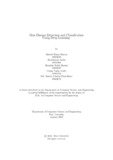| dc.contributor.advisor | Rhaman, Md. Khalilur | |
| dc.contributor.author | Shuvon, Mehedi Hasan | |
| dc.contributor.author | Sadia, Rowshanara | |
| dc.contributor.author | Shormi, Shanjida Habib | |
| dc.contributor.author | Arafin, Umma Tania | |
| dc.contributor.author | Chowdhury, Md. Rawha Mikdad | |
| dc.date.accessioned | 2022-07-24T06:37:06Z | |
| dc.date.available | 2022-07-24T06:37:06Z | |
| dc.date.copyright | 2022 | |
| dc.date.issued | 2022-01 | |
| dc.identifier.other | ID 18101686 | |
| dc.identifier.other | ID 18101188 | |
| dc.identifier.other | ID 18101097 | |
| dc.identifier.other | ID 18201203 | |
| dc.identifier.other | ID 18101672 | |
| dc.identifier.uri | http://hdl.handle.net/10361/17027 | |
| dc.description | This thesis is submitted in partial fulfillment of the requirements for the degree of Bachelor of Science in Computer Science, 2022. | en_US |
| dc.description | Cataloged from PDF version of thesis. | |
| dc.description | Includes bibliographical references (pages 36-37). | |
| dc.description.abstract | Skin Diseases have been the primary focus of this study, as they are one of the
most lethal diseases if not diagnosed and treated early. The research will enable
the fields of Medical Science and Computer Science to collaborate in order to save
lives. Although Machine Learning, Deep Learning, and Image Processing have been
utilized previously to treat skin diseases, we are attempting to improve the accuracy
of this work by implementing new models of Image Processing and Deep Learning.
The purpose of this research is to demonstrate how to accurately diagnose Skin
diseases at an early stage using the optimum model. Here we have used three distinct
neural models to classify a custom dataset. We further analyzed the accuracy of
the MobileNetV2, InceptionV3, and ResNetV2 to come up with an optimized model
that can be configured further to a mobile application for vast use. We built the
architecture on more than 1450 images representing nine distinct skin disorders in
comparison with fresh skin. We carefully compared our data and classified it based
on the images of our customized dataset. Finally, we determined the nine diseases
with a 96.77% accuracy with the help of MobileNetV2 which is our ideal model for
the goal we want to achieve. | en_US |
| dc.description.statementofresponsibility | Mehedi Hasan Shuvon | |
| dc.description.statementofresponsibility | Rowshanara Sadia | |
| dc.description.statementofresponsibility | Shanjida Habib Shormi | |
| dc.description.statementofresponsibility | Umma Tania Arafin | |
| dc.description.statementofresponsibility | Md. Rawha Mikdad Chowdhury | |
| dc.format.extent | 37 pages | |
| dc.language.iso | en | en_US |
| dc.publisher | Brac University | en_US |
| dc.rights | Brac University theses are protected by copyright. They may be viewed from this source for any purpose, but reproduction or distribution in any format is prohibited without written permission. | |
| dc.subject | Image processing | en_US |
| dc.subject | Deep learning | en_US |
| dc.subject | MobileNetV2 | en_US |
| dc.subject | InceptionV3 | en_US |
| dc.subject | ResNetV2 | en_US |
| dc.subject | Epoch | en_US |
| dc.subject | Softmax | en_US |
| dc.subject | Skin disease | en_US |
| dc.subject | KNN | en_US |
| dc.subject | CNN | en_US |
| dc.subject | Detection | en_US |
| dc.subject | Tensorflow | en_US |
| dc.subject | Keras Layer | en_US |
| dc.subject | Dense layer | en_US |
| dc.subject.lcsh | Machine learning | |
| dc.subject.lcsh | Image processing -- Digital techniques. | |
| dc.subject.lcsh | Cognitive learning theory (Deep learning) | |
| dc.title | Skin disease detection and classification using deep learning | en_US |
| dc.type | Thesis | en_US |
| dc.contributor.department | Department of Computer Science and Engineering, Brac University | |
| dc.description.degree | B. Computer Science | |

